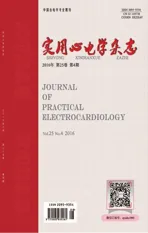胃食管反流病与心房颤动
2016-04-04崔丽综述李广平刘彤审校
崔丽 综述 李广平 刘彤 审校
胃食管反流病与心房颤动
崔丽 综述李广平刘彤 审校
心房颤动(房颤)是临床上最常见的持续性心律失常,可导致患者死亡率升高。胃食管反流是消化科的常见病症,是胃内容物反流入食管引起的不适症状和/或并发症。有研究报道胃食管反流可能会引起房颤。炎症、迷走神经刺激和慢性心房缺血可能是其中的重要机制,炎症反应和自主神经功能异常参与房颤和胃食管反流病的发生发展。本文结合国内外文献对房颤与胃食管反流间的关系及其可能机制进行综述。
心房颤动;胃食管反流病;相关性
R540.41
A
2095-9354(2016)04-0294-04
胃食管反流病(gastroesophageal reflux disease,GERD)与心房颤动(房颤)是临床上的常见疾病。近年来多项研究表明GERD与房颤的发生存在密切联系,本文主要就GERD与房颤关系的相关研究进展及其可能机制进行综述。
1 GERD 与房颤的关系
GERD是指胃内容物反流入食管而引起不适症状和/或并发症的一种疾病,临床十分常见,不同人群年发病率不同,总体发病率在0.8%至40%之间[1],西方国家较高约为10%~20%,亚洲国家为5%,但近年来其发病率也逐年升高,近10年增长4.7%(从11.6%升至17.1%)[2]。GERD患者的临床表现复杂多样,其典型症状包括胃烧灼感和反流,非典型症状有胸痛、上腹痛、上腹烧灼感、嗳气等,以及食管外症状咳嗽、咽喉炎、哮喘和牙蚀症等。GERD发病机制复杂,目前认为GERD与年龄、个人生活方式、肥胖、幽门螺杆菌感染、胃食管压力阶差增加、食管裂孔疝和食管下段括约肌(esophageal sphincter,LES)压力下降相关,主要为抗反流防御机制下降和反流物对食管黏膜攻击作用增强[3]。
房颤是临床上最常见的持续性心律失常,老年人群中的发病率较高。国内胡大一等[4]完成的我国首次房颤大规模流行病学研究表明,中国房颤的患病率为0.77%,而且患病率有随年龄显著增加的趋势,80岁以上人群房颤患病率达7.5%。国内外的资料均显示高龄是影响房颤预后的独立危险因素[5]。国外研究表明,在55~64岁的人群中,每年新发房颤病例为2%~3%,在85~94岁人群中每年新发病例高达35%。房颤可引起患者心力衰竭及卒中风险增加,生活质量下降,有很高的致残率和死亡率。房颤常常与高血压、冠心病、瓣膜性心脏病、充血性心力衰竭、心肌病和糖尿病相关。
1.1GERD是房颤发生的独立危险因素
Kunz等[6]入选2001年1月至2007年10月美国卫生保健系统中163 627例患者,GERD和房颤的诊断采用ICD-9疾病诊断编码,其中房颤的发生率为5%,GERD的发生率为29%,结果表明GERD患者有较高的房颤发生率(RR=1.39),校正其他危险因素(年龄、男性、高血压、冠心病、糖尿病、高脂血症及吸烟)后GERD仍为房颤的独立危险因素(RR=1.19)。Huang等[7]从台湾国民健康数据库中选取29 688例GERD患者和29 597例无GERD、无心律失常病史的患者,随访3年期间共有351例发生房颤,其中GERD组184例(0.62%)、对照组为167例(0.56%),时序检验表明GERD组房颤发生率明显高于对照组(P=0.024),Cox回归比例风险模型分析显示GERD患者有较高的房颤发生率 (HR=1.31,P=0.013)。此外GERD与房颤关系不同研究间尚存在争议,Bunch等[8]调查随访5 288例患者,排除既往房颤病史,其中2 577例(49%)合并GERD,随访(11.4±5.0)年,期间共741例(14%)发生房颤,结果发现GERD是房颤发生的保护因素(HR=0.81,P=0.013),然而进一步分析显示GERD症状发作频繁(每日发作)组具有较高的房颤发生率,但无明显统计学差异(HR=1.54,P=0.07);分析食管炎亚组房颤发生率26%(45/178),发生率明显高于非食管炎组14%(696/5 115)(HR=1.94,P<0.001),但校正年龄、性别、高血压史和心力衰竭病史后两组间房颤发生率比较,差异无统计学意义。
1.2房颤预测GERD发生
Kubota等[9]对479例(201例门诊和278例社区查体)患者进行分析,年龄(60.4±12.8)岁,男性患者255例,应用GERD症状调查问卷(F-scale)进行频度分析;按照房颤类型将患者分为61例持续性房颤、25例阵发性房颤和393例窦性心律,三组F-scale总积分分别为(3.15±3.58)、(2.72±3.01)和(1.70±3.25),可见GERD的发病率持续性房颤高于阵发性房颤,阵发性房颤高于窦性心律者,而冠心病、高血压、糖尿病、高脂血症与F-scale总积分和GERD的发病率无明显相关。回归分析显示房颤患者GERD的发病率显著升高,多因素分析显示非瓣膜性房颤是症状性GERD的独立危险因素(P=0.004)。此外,Shimazu等[10]纳入188例门诊患者,年龄(60.4± 0.9)岁,女78例;86例(46%)合并房颤,其中25例阵发性房颤,61例持续性房颤(包括12例瓣膜性房颤),通过GERD症状调查问卷(F-scale)进行频度积分 [频度积分>8分可诊断GERD,其敏感性62%,特异性59%][11],发现与窦律患者相比,房颤组GERD总积分明显升高(P=0.019),单因素和多因素分析发现房颤是GERD症状的独立危险因素(P<0.001),然而阵发性房颤与持续性房颤组间比较,差异无统计学意义。
1.3治疗GERD对房颤转归的影响
Weigl等[12]对胃镜确诊的89例反流性食管炎患者行心电监测筛选出18例特发性房颤患者,均接受标准的质子泵抑制剂(proton pump inhibitor,PPI)治疗2个月,14例(78%)胃肠道及房颤相关症状均得到改善,并能维持窦性心律,且抗心律失常药物剂量无增加,其中5例停用了抗心律失常药物,认为针对食管炎进行充分的治疗对反流性食管炎患者合并房颤的控制可能是有益的。
1.4GERD患者合并房颤的特点
一项前瞻性、对照研究中问卷调查显示合并GERD和/或应激性肠病(irritable bowel syndrome,IBS)的房颤患者(GI组)和基本信息匹配的非GI组相比具有更多的房颤发作的触发事件(排便、腹胀、进食碳酸饮料/酒/冷水/油腻食物);射频消融治疗期间GI组迷走反射事件(窦性心动过缓、RR间期延长>50%、停搏、房室阻滞、低血压、血压下降≥30 mmHg)发生率更高(60%vs. 13%;P<0.001)。电解剖标测显示GI组左房瘢痕发生率少于非GI组(29.6%vs. 29.8%;P=0.02),随访一年后56例(93%)房颤患者停用抗心律失常药物,两组间比较差异无统计学意义[13]。
1.5GERD与射频消融后房颤复发的关系
Lioni等[14]对88例房颤消融治疗的患者进行随访(8.3±3.1)个月,25例(28.4%)房颤复发,单因素logistic回归分析表明P波间期、P波离散度、左房内径、高血压、冠心病及GERD均与房颤复发相关,多元回归分析表明仅GERD (OR=8.501,P=0.011)是房颤复发的独立危险因素,表明GERD是阵发房颤消融治疗后房颤复发的独立预测因素。
2 GERD与房颤相关的可能机制
大量的证据表明GERD与房颤密切相关,但具体机制尚不十分清楚,可能与以下机制有关。
2.1共同危险因素
研究表明大多数房颤患者多合并高血压、肥胖或糖尿病等导致左房重构的疾病,即使特发性房颤患者冠心病发病率也高于窦性心律者。心房颤动与胃食管反流病最常见的基础疾病是肥胖和增龄。此外,这两种疾病也常与睡眠呼吸暂停或糖尿病相关。
2.2迷走神经刺激
由于一过性食管下括约肌松弛和膈肌的活动受迷走神经控制,因而反流症状也受到自主神经功能紊乱影响。而食道的化学、电及机械性刺激均可调整交感-迷走平衡,Tougas等[15]通过对食道进行酸灌注后出现胸痛(酸敏感者)的心率变异性分析显示GERD患者迷走神经活动明显增加。GERD患者射频消融治疗时迷走反射事件更多[11]。自主神经系统功能紊乱是房颤触发和持续的重要因素,迷走神经张力增加减慢窦房结除极和房室结传导从而触发房颤,且迷走神经过度刺激可缩短心房不应期,从而增加心房离散度和减少折返通路促进多子波折返的形成,使房颤易于维持[16]。迷走神经释放乙酰胆碱作用于壁细胞受体增加胃酸分泌和LES松弛放松,促进酸性胃内容物进入食道产生GERD。可见GERD与房颤可能是同一种机制所致的两种疾病,均是由迷走神经过度刺激所致。
2.3局部炎症反应
炎症与房颤关系密切,是房颤发病的影响因素之一[17]。食道与左房相毗邻,GERD所致心房局部炎症因子水平的增加,可触发GERD患者房颤的发生。多项研究显示刺激食管上皮细胞可分泌多种炎症介质如高敏C-反应蛋白(CRP),白介素(IL-1、IL-6、IL-8)及TNF-ɑ等,这些炎症因子与房颤患者心房及肺静脉组织过度表达中的炎症因子高度一致[18-19]。此外,GERD患者食道黏膜的IL-8明显增加,且IL-8水平与疾病严重程度密切相关,IL-8作为嗜中性粒细胞的强诱导剂,诱导外周血白细胞的迁移并激活产生氧自由基加重组织坏死和细胞凋亡[20]。Rieder等[21]研究显示食管炎组食管黏膜组织中IL-1β和IL-6表达较非食管炎组显著增加,体外培养食道黏膜上皮予以胃酸刺激可促进细胞IL-6的表达,而IL-6可使食管括约肌收缩力下降、胃食管返流增加。多项研究[22-23]显示炎症因子在房颤发生发展中发挥重要作用。同时房颤患者扩大的左房可能压迫或刺激毗邻的食管下段组织导致胃食管反流症状。
2.4慢性心房缺血
Chauhan等[24]研究表明冠心病患者予以食管酸刺激后冠脉血流量显著下降[(70.4±14.3)mL/minvs. (46.4±19.1)mL/min,P<0.01],而予以盐水后冠脉血流无影响[(73.5±15.3)mL/minvs. (72.5±14.0)mL/min],可见胃食管反流可能造成冠脉血流减少,产生慢性心房缺血从而触发房颤。
3 问题与展望
GERD与房颤关系密切,GERD可作为房颤的独立危险因素,同时房颤被认为是GERD食道外症状之一。但GERD引起房颤的具体机制尚不完全清楚,治疗GERD对房颤的复发及其预后的影响仍需进一步研究。
[1] Vakil N. Disease definition, clinical manifestations, epidemiology and natural history of GERD[J]. Best Pract Res Clin Gastroenterol, 2010, 24(6):759-764.
[2] Ness-Jensen E, Lindam A, Lagergren J, et al. Changes in prevalence, incidence and spontaneous loss of gastro-oesophagealreflux symptoms: a prospective population-based cohort study, the HUNT study[J]. Gut, 2012, 61(10):1390-1397.
[3] Parasa S, Sharma P. Complications of gastro-oesophageal reflux disease[J]. Best Pract Res Clin Gastroenterol, 2013, 27(3):433-442.
[4] 周自强,胡大一,陈捷,等.中国心房颤动现状的流行病学研究[J].中华内科杂志,2004,43(7):491-494.
[5] 姚光辉. 62例高龄病例心房颤动的临床分析[J]. 江苏实用心电学杂志,2012,21,(1):13-15.
[6] Kunz JS, Hemann B, Edwin Atwood J, et al. Is there a link between gastroesophageal reflux disease and atrial fibrillation?[J]. Clin Cardiol, 2009, 32(10):584-587.
[7] Huang CC, Chan WL, Luo JC, et al. Gastroesophageal reflux disease and atrial fibrillation: a nationwide population-based study[J]. PLoS One, 2012, 7(10):e47575.
[8] Bunch TJ, Packer DL, Jahangir A, et al. Long-term risk of atrial fibrillation with symptomatic gastroesophageal reflux disease and esophagitis[J]. Am J Cardiol, 2008, 102(9):1207-1211.
[9] Kubota S, Nakaji G, Shimazu H, et al. Further assessment of atrial fibrillation as a risk factor for gastroesophageal reflux disease: a multicenter questionnaire survey[J]. Intern Med, 2013,52(21):2401-2407.
[10] Shimazu H, Nakaji G, Fukata M, et al. Relationship between atrial fibrillation and gastroesophageal reflux disease: a multicenter questionnaire survey[J]. Cardiology, 2011, 119(4):217-23.
[11] Kusano M, Hosaka H, Kawada A, et al. Development and evaluation of a modified Frequency Scale for the Symptoms of Gastroesophageal Reflux Disease to distinguish functional dyspepsia from non-erosive reflux disease[J]. J Gastroenterol Hepatol,2012, 27(7):1187-1191.
[12] Weigl M, Gschwantler M, Gatterer E, et al. Reflux esophagitis in the pathogenesis of paroxysmal atrial fibrillation: results of a pilot study[J]. South Med J, 2003, 96(11):1128-1132.
[13] Reddy YM, Singh D, Nagarajan D, et al. Atrial fibrillation ablation in patients with gastroesophageal reflux disease or irritable bowel syndrome-the heart to gut connection[J]. J Interv Card Electrophysiol, 2013, 37(3): 259-265.
[14] Lioni L, Letsas KP, Efremidis M, et al. Gastroesophageal reflux disease is a predictor of atrial fibrillation recurrence following left atrial ablation[J]. Int J Cardiol, 2015,183:211-213.
[15] Tougas G, Spaziani R, Hollerbach S, et al. Cardiac autonomic function and oesophageal acid sensitivity in patients with non-cardiac chest pain[J]. Gut, 2001, 49(5):706-712.
[16] Ravelli F, Allessie M. Effects of atrial dilatation on refractory period and vulnerability to atrial fibrillation in the isolated Langendorff-perfused rabbit heart [J]. Circulation, 1997, 96(5): 1686-1695.
[17] 黄赟,潘闽. 心房颤动与炎症关系的研究进展[J]. 江苏实用心电学杂志, 2014, 23(3):204-207.
[18] Li J, Solus J, Chen Q, et al. Role of inflammation and oxidative stress in atrial fibrillation[J]. Heart Rhythm, 2010, 7(4):438-444.
[19] Gerson LB, Friday K, Triadafilopoulos G. Potential relationship between gastroesophageal reflux disease and atrial arrhythmias[J]. J Clin Gastroenterol, 2006, 40(9): 828-832.
[20] Yoshida N, Uchiyama K, Kuroda M, et al. Interleukin-8 expression in the esophageal mucosa of patients with gastroesophageal reflux disease[J]. Scand J Gastroenterol, 2004, 39(9):816-822.
[21] Rieder F, Cheng L, Harnett KM, et al. Gastroesophageal reflux disease-associated esophagitis induces endogenous cytokine production leading to motor abnormalities[J]. Gastroenterology, 2007,132(1):154-165.
[22] Liu T, Li G. Is atrial fibrillation an inflammatory disease? [J]. Med Hypotheses, 2005, 64(6): 1237-1238.
[23] Liu T, Li G, Li L, et al. Association between C-reactive protein and recurrence of atrial fibrillation after successful electrical cardioversion: a meta-analysis[J]. J Am Coll Cardiol, 2007, 49(15):1642-1648.
[24] Chauhan A, Mullins PA, Taylor G, et al. Cardioesophageal reflex: a mechanism for “linked angina” in patients with angiographically proven coronary artery disease[J]. J Am Coll Cardiol,1996, 27(7):1621-1628.
(本文编辑:郭欣)
Relationship between gastroesophageal reflux disease and atrial fibrillation
Cui Li, Li Guang-ping, Liu Tong
(Tianjin Key Laboratory of Ionic-Molecular Function of Cardiovascular Disease; Department of Cardiology, the Second Hospital of Tianjin Medical University; Tianjin Institute of Cardiology, Tianjin 300211, China)
Atrial fibrillation(AF) is the most common sustained arrhythmia which contributes to the increasing mortality risk in clinical practice. Gastroesophageal reflux disease(GERD) is commonly seen in the department of Gastroenterology. It refers to discomfortable symptoms and(or) complications caused by the reflux of gastric contents into esophagus. It was reported that gastroesophageal reflux may give rise to AF. Inflammation, vagal stimulation and chronic atrial ischemia may be important potential mechanisms; inflammatory responses and autonomic nervous dysfunction take part in the onset and development of AF and GERD. Based on correlative domestic and foreign references, this paper reviews the relationship between AF and GERD, and its possible mechanisms.
atrial fibrillation; gastroesophageal reflux disease; relativity
国家自然科学基金资助项目(81270245, 81570298)
300211天津,天津市心血管病离子与分子机能重点实验室,天津医科大学第二医院心脏科,天津心脏病学研究所
崔丽,主治医师,医学博士,主要从事冠心病、心律失常的基础与临床工作。
刘彤,E-mail:liutongdoc@126.com
综述
10.13308/j.issn.2095-9354.2016.04.018
2016-07-16)
